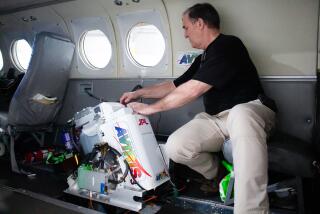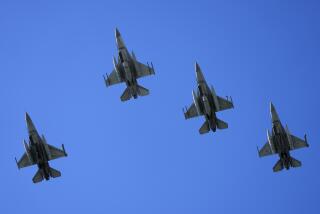NASA Boasts Sophisticated ‘Air Force’ : Research: A fleet of 108 aircraft, including everything from advanced jet fighters and helicopters to jumbo jets, is used by the space agency in a variety of pursuits.
- Share via
MOUNTAIN VIEW, Calif. — The ungainly looking airplane with long, droopy wings looks more like a glider than a spacecraft, but it sounds like a rocket as it roars off the runway.
The ER-2 soars almost straight up into a hazy sky. In seconds it is a distant pinpoint.
Successors to the U-2 spy planes of the Cold War days in the 1950s, the three ER-2 aircraft flown here at NASA’s Ames Research Center can cruise at 70,000 feet.
These days they are used to investigate Earth’s atmosphere. Their instruments recently collected valuable data on the Antarctic ozone hole.
Often forgotten in the hoopla surrounding space shuttles and satellites, NASA’s 108 aircraft constitute an “air force” unlike any other. The sophisticated fleet includes everything from advanced jet fighters and helicopters to airborne observatories and Boeing 747 jumbo jets that ferry space shuttles on their backs.
The largest number of planes are the 29 aging T-38A twin-engine jets based at the Johnson Space Center in Houston. Astronauts use them to maintain their flying skills.
But the focus for the key components of NASA’s air force is science or research, and nowhere is this more evident than at Ames and its affiliate, the Dryden Flight Research Facility near Los Angeles.
At Ames, the fastest known planes in the world--three SR-71 Blackbirds acquired from the Air Force--will be used to study concepts for a new transport that could fly in the upper fringes of the atmosphere at speeds of more than 4,000 m.p.h.
“We’re here to conduct aeronautical flight research for the aerospace community,” explains Theodore G. Ayers, Dryden’s deputy director. “We’re willing to take the risks where industry is unwilling to do so.
“Our goal is to provide the advanced technology that can be used in future aircraft or spacecraft.”
Experts at Dryden are trying to integrate the engine and flight controls on an F-15 fighter, the mainstay of the Air Force’s interceptor fleet. The goal is to program the aircraft so it can land using only engine controls, even if vital components such as ailerons, rudders, elevators and flaps are damaged.
Technicians are also putting a sleek, unusual delta-wing F-16XL Air Force jet through its paces to learn more about the influence of air flow on aircraft at sustained supersonic speeds. The wing design is similar to those being considered for future supersonic passenger jets.
Ayers thinks it’s time to look at radical alternatives such as a “flying wing.”
“An advanced transport could be a swept wing with no body at all, capable of carrying 600 or more people,” he says. “Other aircraft of the future might sport twin fuselages. I think we’re so prejudiced as to what we think an airplane should look like that we need to open our minds a bit.”
At the other extreme is NASA’s vintage B-52 bomber, the oldest still flying. It has been at Dryden since 1959.
“We would never have been able to predict all the programs it has served,” says Milton O. Thompson, chief engineer at the flight research facility. “Now it’s sometimes used as a rocket platform.”
To lower launch costs and increase dependability, winged rockets carrying small satellites are released from the B-52 after it reaches altitudes of 40,000 feet or more. Once in orbit, the rocket deploys the satellites.
At Ames, the large aircraft in the NASA fleet are devoted to science. A converted C-141A military cargo plane equipped with a 36-inch reflecting telescope regularly patrols the skies, the world’s only airborne astronomical research observatory.
Cruising at 41,000 feet, well above most of Earth’s atmosphere and its water vapor, astronomers have used the flying telescope to first sight the rings around Uranus, identify an atmosphere on Pluto and track Halley’s comet.
Plans are under way for an even bigger flying observatory, a Boeing 747 that would carry an eight-foot telescope.
A Douglas DC-8 transport, its long interior divided into a series of workstation cubicles, serves as an airborne research laboratory for scientists with earthbound concerns. Some flights have carried as many as 30 scientists, working on experiments dealing with everything from oceanography to atmospheric chemistry.
Fitted with arrays of sensors, a NASA C-130 Hercules turboprop, a workhorse in both military and civilian cargo fleets, collects information for scientists around the world. “Most of its work involves remote sensing of the Earth, looking at geology, plant growth, soil moisture,” missions manager Mark Koozer says.
“For instance, the aircraft recently returned from Niger, where instruments measuring soil moisture analyzed a slice of the country near the Sahara.”
Some of the most ambitious flight research at Ames involves helicopters.
“We’re using an old Cobra gunship in experiments involving voice controls,” says James L. Martin, chief of the Ames research aircraft operations division.
“Eventually, we hope, a pilot will be able to talk to a computer which would recognize his voice and carry out his commands. Instructions might be anything from readying the guns to tuning radio frequencies or reading out certain emergency procedures.”
Besides the noise inside a helicopter, one of the biggest drawbacks to such a scheme has been the inflections in a pilot’s voice.
“When people get excited or stressed, their voices change a little bit, and we haven’t been able to compensate for that yet,” Martin says.
Other experiments with the Cobra may someday give helicopters some guided-missile capabilities. Pilots would like a system that would automatically enable a chopper to hug the ground while avoiding obstacles--much as Tomahawk cruise missiles did during the Persian Gulf War.
According to Martin, that’s the goal of the Automated-Nap-of-the-Earth program, which would link a digital terrain map and computer in the cockpit, enabling pilots to use the lay of the land to guide them to their targets.
More to Read
Sign up for Essential California
The most important California stories and recommendations in your inbox every morning.
You may occasionally receive promotional content from the Los Angeles Times.










